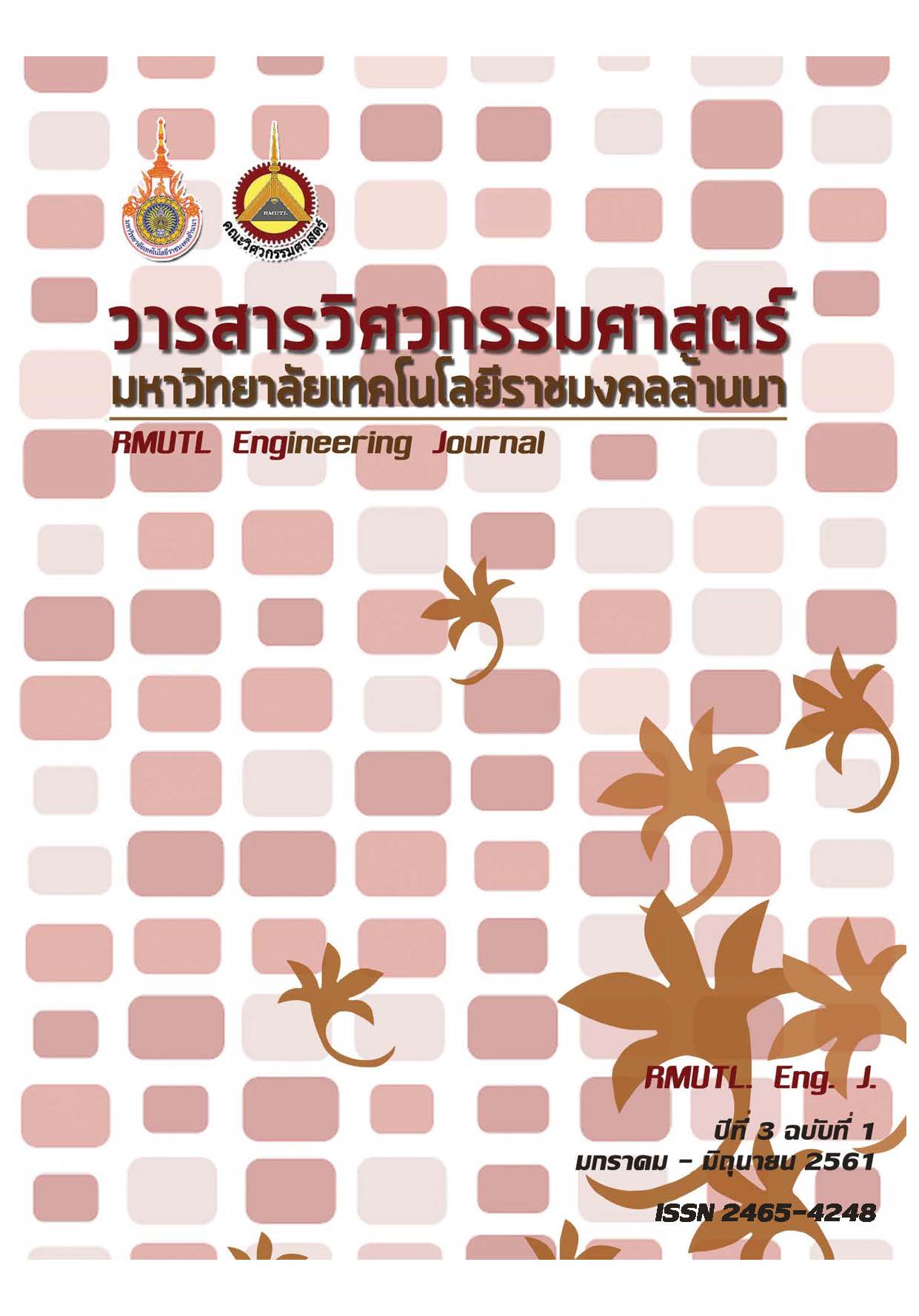Biological Effect from Mobile Phone to Human Head and Brain
DOI:
https://doi.org/10.14456/rmutlengj.2018.1Keywords:
Specific Absorption Rate, power loss density, power patternAbstract
This article describes research entitled the simulation of effect from mobile phone to human head and brain. Based on three variables, they are comprised of electrical properties, averaged mass tissues of human head and brain and frequencies of electromagnetic wave from the phone. The results of this simulation are power pattern of mobile phone, Specific Absorption Rate (SAR) and power loss density in human head. The research uses Flat Specific Anthropomorphic Mannequin (SAM) combined with IEEE mobile phone. The two methods named Perfect Boundary Approximation (PBA) and Thin Sheet Technique (TST) are used to be mesh dividing. Finite Difference Time Domain numerical method is used to analyze. The results are found that SAR values in all conditions are in the range of 0.013-9.95 W/kg. The second point, the SAR values are increased according to averaged mass tissues and frequencies. Then, the area of SAR values of 1800 MHz is the narrowest due to - 60 degree Main Lobe direction. Finally, the power loss density varies directly with frequencies.
References
2. World Health Organization, Electromagneticfields and public health: mobile phones,2014.
3. J.G. Eduard, C. Moraru, and R. Mihai, “Study of Energy Absorption Field Emitted by Generic Mobile Phone at 900 MHz Frequency”, 9th International Conference on Communications (COMM), Bucarest, 2012, pp.267-270.
4. Lee A. K. and Yun J., “A Comparison of Specific Absorption Rates in SAM Phantom and Child Head Models at 835 and 1900 MHz”,IEEE Transactions on Electromagnetic Compatibility Vol.53 No.3, (March 2011) : 619-627.
5 Hadjem A., et al., “Analysis of Power Absorbed by Children’s Head as a Result of New Usages of Mobile Phone”, IEEE Transactions on Electromagnetic Compatibility, Vol.52. No.4. (August 2010) : 812-819.
6. C. Sriprasoet and A. Pruksanubal, “Effects of Ring Metallic Objects on Specific Absorption Rate in Human Head Caused by Mobile Phone”, 12th International conference on Electrical Engineering/Electronics, Computer, Telecom-munications and Information Technology, Hua Hin, Thailand, 2015.
7. A.Hirata et.al., “Temperature Increase in the Human Head Due to a Dipole Antenna at Microwave Frequencies”, IEEE transactions on Electromagnetic Compatibility, Vol.45, No.1, Feb. 2003.
8. Behari J and Nirala JP, “Specific absorption rate variation in a brain phantom due to exposure by a 3G mobile phone: problems in dosimetry”, Indian J Exp Biol. 2013 Dec;51 (12):1079-85.
9. P. Poungsri and A. Pruksanubal, “The biological effect from mobile phone in human head”, 13th International conference on Electrical Engineering/Electronics, Computer, Telecommunications and Information Technology, Chiangmai, Thailand, 2016.
10. Soo-Ji Lee, el at., “Bandwidth Enhanced Tri-Band Monopole Slot Antenna on Ultra- Thin Metal Housed Devices”, The 44th European Microwave Conference, Italy, Oct 2014.
11. G. Schmid et. al., “Bestimmung der Expositionsverteilung von HF Feldern im menschlichen Koerper_unter Beruecksichtigung kleiner Strukturen und thermophysiologisch relevanter Parameter”,Forschungsvorhaben, Deutschland, 2008.
12. Institute of Electrical and Electronics Engineers. “Recommended Practice for the Measurement of Potentially Hazardous Electromagnetic Fields - RF and Microwave” IEEE Standard C95.3TM-1991. [serial online] 1991 : 1-93.
13. Institute of Electrical and Electronics Engineers. “Standard for Safety Levels with Respect to Human Exposure to Radio Frequency Electromagnetic Fields, 3 kHz to 300 GHz.” IEEE Standard C95.1TM-2005.[serial online] 2005 : 1-238.
14. Institute of Electrical and Electronics Engineers.“Recommended Practice for Determining the Peak Spatial-Average Specific Absorption Rate (SAR) in the Human Head from Wireless Communications Devices: Measurement Techniques.”IEEE Std 1528TM– 2013. [serial online] 2013 : 1-246.
15. International Commission on Non-Ionizing Radiation Protection, “ICNIRP Guidelines for limiting exposure to time-varying electric, magnetic, and electromagnetic fields (up to 300 GHz).” Health Physics 74 (4), [serial online] 1998 : 494-522.
16. Ervin Joo, “Absorption of The Electromagnetic Energy in Human Head”, Doctoral Dissertation, 2005.
17. Lias K., et al. “Biological Effect of 900 MHz and 1800 MHz Mobile Phones in SAR Weight.”In IEEE. 2nd International Conference on Information and Multimedia Technology (ICIMT), Jeju Island, 2009 : (422-425).
18. Andre V. Vorst, Arye Rosen and Youji Kotsuka, RF/Microwave Interaction with Biological Tissues, Wiley-Interscience, 2006.
19. Constantine A. Balanis, Antenna Theory Analysis and Design, Wiley-Interscience, 3rd Edition, 2005.
20. K. Huang and Y. Liao, “Transient Power Loss Density of Electromagnetic Pulse in Debye Media”, IEEE Trans. on Microwave Theory and Techniques, Vol.63, No.1, Jan. 2015.










